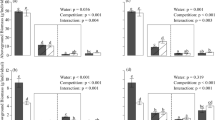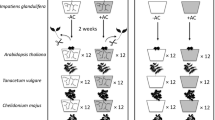Abstract
Impacts of invasive species are context-dependent owing to genetic differences in the invasive species, in the abiotic environment or the recipient biotas. Here, we tested how these factors affected the invasive grass Melinis minutiflora and its impacts on native plants in Hawai’i (USA) and in the Brazilian Cerrado under four environmental conditions. We sampled M. minutiflora and three native species from each studied region and conducted two equivalent greenhouse experiments. In each experiment, we manipulated shade, irrigation, soil nutrients, and interspecific competition. We found that M. minutiflora had low genetic polymorphism, and two distinct genetic clusters exist. Both clusters exist in Hawai’i and Brazil. Melinis minutiflora biomass was three-times greater in Brazil compared to Hawai’i. Both in Brazil and Hawai’i, M. minutiflora was affected by shade, irrigation, and competition. While in Brazil the identity of the competing native species did not matter for M. minutiflora, in Hawai’i the identity of the native species affected M. minutiflora when shade was applied. Brazilian native species were all affected by shading, two of them by competition with M. minutiflora, and one of them by fertilization. Two Hawaiian native plants were affected by shade and competition with M. minutiflora, whereas one native species was not affected by any of the experimental factors. In summary, both biotic and abiotic factors affected native and invasive species. However, in all cases native species were outperformed by the invader.





Similar content being viewed by others
References
Almeida-Neto M, Prado PI, Kubota U et al (2010) Invasive grasses and native Asteraceae in the Brazilian Cerrado. Plant Ecol 209:109–122
Bellard C, Cassey P, Blackburn TM (2016) Alien species as a driver of recent extinctions. Biol Lett 12:20150623. https://doi.org/10.1098/rsbl.2015.0623
Carthey AJR, Banks PB (2014) Naïveté in novel ecological interactions: lessons from theory and experimental evidence. Biol Rev 89:932–949. https://doi.org/10.1111/brv.12087
Cook B, Pengelly B, Brown S et al (2005) Tropical forages: an interactive selection tool. CSIRO, DPI&F(Qld), CIAT and ILRI, Brisbane, Australia
Crawford KM, Whitney KD (2010) Population genetic diversity influences colonization success. Mol Ecol 19:1253–1263. https://doi.org/10.1111/j.1365-294X.2010.04550.x
D’Antonio CM, Dudley TL (1995) Biological invasions as agents of change on islands versus mainlands. In: Vitousek PM, Loope LL, Adsersen H (eds) Islands: biological diversity and ecosystem function. Springer, Berlin, pp 103–121
Diez JM, Williams PA, Randall RP et al (2009) Learning from failures: testing broad taxonomic hypotheses about plant naturalization. Ecol Lett 12:1174–1183. https://doi.org/10.1111/j.1461-0248.2009.01376.x
Doyle JJ, Doyle JL (1987) A rapid DNA isolation procedure for small quantities of fresh leaf tissue. Phytochem Bull 19:11–15
Earl DA, VonHoldt BM (2012) STRUCTURE HARVESTER: a website and program for visualizing STRUCTURE output and implementing the Evanno method. Conserv Genet Resour 4:359–361. https://doi.org/10.1007/s12686-011-9548-7
Eller CB, Oliveira RS (2017) Effects of nitrogen availability on the competitive interactions between an invasive and a native grass from Brazilian cerrado. Plant Soil 410:63–72. https://doi.org/10.1007/s11104-016-2984-0
Evanno G, Regnaut S, Goudet J (2005) Detecting the number of clusters of individuals using the software structure: a simulation study. Mol Ecol 14:2611–2620. https://doi.org/10.1111/j.1365-294X.2005.02553.x
Ferreira ME, Grattapaglia D (1998) Introdução ao uso de marcadores moleculares em análise genética, 3rd edn. Embrapa-Cenargen, Brasília, Brazil
Gimeno I, Vilà M, Hulme PE (2006) Are islands more susceptible to plant invasion than continents? A test using Oxalis pes-caprae L. in the western Mediterranean. J Biogeogr 33:1559–1565
Hardesty BD, Le Roux JJ, Rocha OJ et al (2012) Getting here from there: testing the genetic paradigm underpinning introduction histories and invasion success. Divers Distrib 18:147–157. https://doi.org/10.1111/j.1472-4642.2011.00832.x
Hierro JL, Maron JL, Callaway RM (2005) A biogeographical approach to plant invasions: the importance of studying exotics in their introduced and native range. J Ecol 93:5–15. https://doi.org/10.1111/j.1365-2745.2004.00953.x
Hoffmann WA, Haridasan M (2008) The invasive grass, Melinis minutiflora, inhibits tree regeneration in a Neotropical savanna. Austral Ecol 33:29–36. https://doi.org/10.1111/j.1442-9993.2007.01787.x
Kueffer C, Daehler CC, Torres-Santana CW et al (2010) A global comparison of plant invasions on oceanic islands. Perspect Plant Ecol Evol Syst 12:145–161. https://doi.org/10.1016/j.ppees.2009.06.002
Longhi-Wagner HM (1990) Diversidade e distribuição geográfica das espécies de Aristida L. (Gramineae) ocorrentes no Brasil. Acta Bot Brasil 4:105–124
Martins CR (2006) Caracterização e manejo da gramínea Melinis minutiflora P. Beauv. (Capim-gordura): uma espécie invasora do Cerrado. Universidade de Brasília
Pivello V, Shida C, Meirelles S (1999) Alien grasses in Brazilian savannas: a threat to the biodiversity. Biodivers Conserv 8:1281–1294
Porras-Hurtado L, Ruiz Y, Santos C et al (2013) An overview of STRUCTURE: applications, parameter settings, and supporting software. Front Genet. https://doi.org/10.3389/fgene.2013.00098
Pritchard JK, Stephens M, Donnelly P (2000) Inference of population structure using multilocus genotype data. Genetics 155:945–959. https://doi.org/10.1111/j.1471-8286.2007.01758.x
Quinn GP, Keough MJ (2002) Experimental design and data analysis for biologists. Cambridge University Press, New York
Rossi RD, Martins CR, Viana PL et al (2014) Impact of invasion by molasses grass (Melinis minutiflora P. Beauv.) on native species and on fires in areas of campo-cerrado in Brazil. Acta Bot Brasil 28:631–637
van Kleunen M, Dawson W, Essl F et al (2015) Global exchange and accumulation of non-native plants. Nature 525:100–103. https://doi.org/10.1038/nature14910
Yelenik SG, D’Antonio CM (2013) Self-reinforcing impacts of plant invasions change over time. Nature 503:517–520. https://doi.org/10.1038/nature12798
Zenni RD, Nuñez MA (2013) The elephant in the room: the role of failed invasions in understanding invasion biology. Oikos. https://doi.org/10.1111/j.1600-0706.2012.00254.x
Zenni RD, Ziller SR (2011) An overview of invasive plants in Brazil. Braz J Bot 34:431–446
Zenni RD, Bailey JK, Simberloff D (2014) Rapid evolution and range expansion of an invasive plant are driven by provenance–environment interactions. Ecol Lett. https://doi.org/10.1111/ele.12278
Zenni RD, Dickie IA, Wingfield MJ et al (2017) Evolutionary dynamics of tree invasions: complementing the unified framework for biological invasions. AoB Plants. https://doi.org/10.1093/aobpla/plw085
Zuur AF, Ieno EN, Walker N et al (2009) Mixed effects models and extensions in ecology with R. Springer, New York
Acknowledgements
We thank Isabel Schmidt, Courtney Angelo, Mashuri Waite, Amy Tsuneyoshi, Travis Idol, Servillano Lamer, Sergio Tadeu Meirelles, and Agno Damasceno for assistance with field and greenhouse work. We thank Carlos Romero Martins, Clyde Imada and Neil Snow for grass specimens’ identification. The study was funded by Fundação de Apoio à Pesquisa de São Paulo (FAPESP) and Natural Grasslands Conservancy. We used the facilities of the University of Hawai‘I, Departments of Botany and NREM, in Hawai’i, and the Juquery State Park in Brazil. RDZ and ABS were supported by CNPq-Brazil.
Author information
Authors and Affiliations
Contributions
RDZ analysed the data and wrote the manuscript. ABS, VRP, and CD designed and carried out the experiments. YPL, MP-F, and TCLL collected data and performed the genetic analyses. All authors revised the manuscript.
Corresponding author
Electronic supplementary material
Below is the link to the electronic supplementary material.
Rights and permissions
About this article
Cite this article
Zenni, R.D., Sampaio, A.B., Lima, Y.P. et al. Invasive Melinis minutiflora outperforms native species, but the magnitude of the effect is context-dependent. Biol Invasions 21, 657–667 (2019). https://doi.org/10.1007/s10530-018-1854-5
Received:
Accepted:
Published:
Issue Date:
DOI: https://doi.org/10.1007/s10530-018-1854-5




